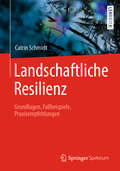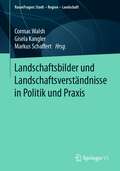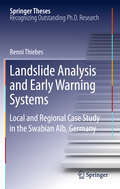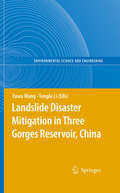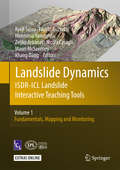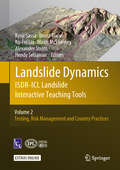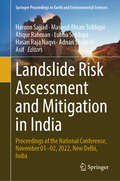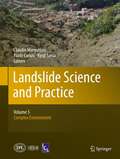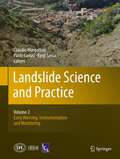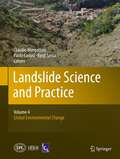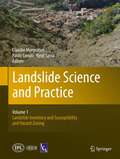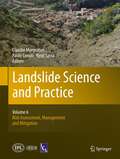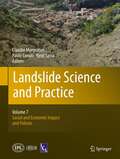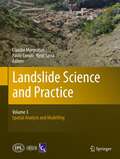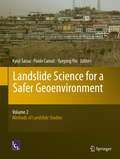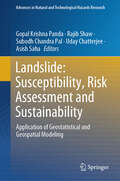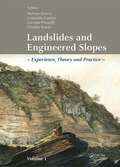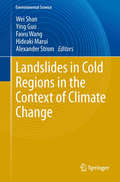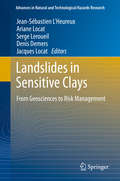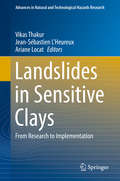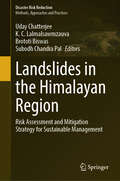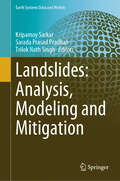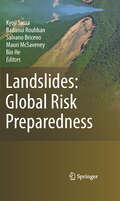- Table View
- List View
Landschaftliche Resilienz: Grundlagen, Fallbeispiele, Praxisempfehlungen
by Catrin SchmidtDieses Buch erklärt was die Resilienz von Landschaften ausmacht. Warum können sich manche Landschaften von Störereignissen oder Krisen rasch wieder erholen, während andere auf absehbare Zeit gänzlich aus der Balance gebracht werden? Die Autorin begibt sich auf die Suche nach den Einflussfaktoren und Bedingungsgefügen landschaftlicher Resilienz und wertet dazu nicht nur den aktuellen Stand der Fachdiskussion aus, sondern erkundet rund um den Globus Landschaften, die kontrastreicher nicht sein könnten: von ariden Agrarlandschaften bis zu borealen Waldlandschaften, von Atollen bis zu Salzlandschaften, von Terrassenlandschaften bis hin zu Städten. Ebenso vielfältig wie die Landschaftstypen sind die betrachteten Faktoren, die Landschaften unter Stress setzen können. So unterschiedlich die Fallbeispiele aber im Einzelnen auch sind, ihr faszinierendes Mosaik zeigt zugleich, dass es übergreifende Prinzipien gibt, mit denen sich die Widerstandsfähigkeit von Landschaften gezielt erhöhen lässt, so dass Landschaften aus Krisen möglichst nicht geschwächt, sondern gestärkt hervorgehen.
Landschaftsbilder und Landschaftsverständnisse in Politik und Praxis (RaumFragen: Stadt – Region – Landschaft)
by Cormac Walsh Gisela Kangler Markus SchaffertDie Governance von Raum, Natur, Umwelt und Kultur ist von unterschiedlichen Landschaftsbildern und Verständnissen von Landschaft geprägt. So haben Bürger*innen, Grundbesitzer*innen, Landschaftsarchitekt*innen, Landbewirtschafter*innen, Naturschützer*innen, Raumplaner*innen, Touristiker*innen eine Reihe von durchaus verschiedenen Lesarten von Landschaft: Natur- oder Kulturlandschaft, genutzte oder verwilderte Landschaft, Landschaft als Privat- oder Gemeinschaftsgut, Landschaft als Schutzgut oder Ressource, Landschaft als physischer Raum oder gesellschaftliches Konstrukt und andere. Die Beiträge in diesem Band machen deutlich, wie vielschichtig sich Landschaftsbilder und Landschaftsverständnisse heute erweisen und wie mannigfaltig die methodischen Entwicklungen und Projekte sind, mit denen wissenschaftliche Erkenntnisse in die Praxis der Governance-Prozesse eingebracht werden.
Landslide Analysis and Early Warning Systems
by Benni ThiebesRecent landslide events demonstrate the need to improve landslide forecasting and early warning capabilities in order to reduce related risks and protect human lives. In this thesis, local and regional investigations were carried out to analyse landslide characteristics in the Swabian Alb region, and to develop prototypic landslide early warning systems. In the local study area, an extensive hydrological and slope movement monitoring system was installed on a seasonally reactivated landslide body located in Lichtenstein- Unterhausen. Monitoring data was analysed to assess the influence of rainfall and snow-melt on groundwater conditions, and the initiation of slope movements. The coupled hydrology-slope stability model CHASM was applied to detect areas most prone to slope failures, and to simulate slope stability using a variety of input data. Subsequently, CHASM was refined and two web-based applications were developed: a technical early warning system to constantly simulate slope stability integrating rainfall measurements, hydrological monitoring data and weather forecasts; and a decision-support system allowing for quick calculation of stability for freely selectable slope profiles. On the regional scale, available landslide inventory data were analysed for their use in evaluation of rainfall thresholds proposed in other studies. Adequate landslide events were selected and their triggering rainfall and snow-melting conditions were compared to intensity-duration and cumulative thresholds. Based on the results, a regional landslide early warning system was developed and implemented as a webbased application. Both, the local and the regional landslide early warning systems are part of a holistic and integrative early warning chain developed by the ILEWS project, and could easily be transferred to other landslide prone areas.
Landslide Disaster Mitigation in Three Gorges Reservoir, China
by Tonglu Li Fawu WangThis book presents the research results on landslide disaster mitigation in Three Gorges Reservoir, China. It consists of three parts. (1) Regional properties of landslides in this area, (2) Case studies about some typical landslides, and (3) New methodologies applied in this area. It provides useful information to academics, practitioners, and university students working on landslide disaster mitigation, especially for large engineering projects. This book can also be used as an information source for geo-hazards in the Three Gorges Reservoir Area.
Landslide Dynamics: ISDR-ICL Landslide Interactive Teaching Tools
by Kyoji Sassa Fausto Guzzetti Hiromitsu Yamagishi Željko Arbanas Nicola Casagli Mauri McSaveney Khang DangThis interactive book presents comprehensive information on the fundamentals of landslide types and dynamics, while also providing a set of PPT, PDF, and text tools for education and capacity development. As the core activity of the Sendai Partnerships, the International Consortium of Landslides has created this two-volume work, which will be regularly updated and improved over the coming years, based on responses from users and lessons learned during its application.
Landslide Dynamics: Testing, Risk Management And Country Practice
by Alexander Strom Kyoji Sassa Binod Tiwari Mauri McSaveney Ko-Fei Liu Hendy SetiawanThis interactive book presents comprehensive information on the fundamentals of landslide types and dynamics, while also providing a set of PPT, PDF, and text tools for education and capacity development. As the core activity of the Sendai Partnerships, the International Consortium of Landslides has created this two-volume work, which will be regularly updated and improved over the coming years, based on responses from users and lessons learned during its application.
Landslide Ecology
by Lawrence R. Walker Aaron B. ShielsDespite their often dangerous and unpredictable nature, landslides provide fascinating templates for studying how soil organisms, plants and animals respond to such destruction. The emerging field of landslide ecology helps us understand these responses, aiding slope stabilisation and restoration and contributing to the progress made in geological approaches to landslide prediction and mitigation. Summarising the growing body of literature on the ecological consequences of landslides, this book provides a framework for the promotion of ecological tools in predicting, stabilising, and restoring biodiversity to landslide scars at both local and landscape scales. It explores nutrient cycling; soil development; and how soil organisms disperse, colonise and interact in what is often an inhospitable environment. Recognising the role that these processes play in providing solutions to the problem of unstable slopes, the authors present ecological approaches as useful, economical and resilient supplements to landslide management.
Landslide Risk Assessment and Mitigation in India: Proceedings of the National Conference, November 01-02, 2022, New Delhi, India (Springer Proceedings in Earth and Environmental Sciences)
by Haroon Sajjad Atiqur Rahman Lubna Siddiqui Masood Ahsan Siddiqui Hasan Raja Naqvi Adnan Shakeel AsifThis book focuses on landslide hazard mapping, identification of site-specific drivers of landslide occurrence, and assessment of landslide susceptibility, vulnerability, risk and mitigation using advanced techniques and approaches. The book encompasses the use of geospatial technologies, artificial intelligence, machine learning algorithms, and advanced statistical models to explore multi-dimensionality of landslide hazard. The book is a synthesis of research papers presented at the National Conference on Landslide Risk Assessment and Mitigation in India, organized by the Department of Geography, Jamia Millia Islamia, New Delhi, India, 01–02 November 2022. The book is organized into four parts made up of 21 chapters. Part I deals with landslide hazard mapping. Part II covers landslide susceptibility mapping and assessment. Part III evaluates landslide risk. Finally, Part IV presents multi-disciplinary approach and holistic mechanism to devise landslide mitigation strategies. The chapters help better understand the intertwined physical processes, causes of landslides, potential risk factors, movement characteristics, and role of engineering and technology to minimize upcoming human, physical and economic losses. The book is a valuable resource for researchers, academicians, stakeholders, and policy makers.
Landslide Science and Practice: Complex Environment
by Claudio Margottini Kyoji Sassa Paolo CanutiThis book contains peer-reviewed papers from the Second World Landslide Forum, organised by the International Consortium on Landslides (ICL), that took place in September 2011. The entire material from the conference has been split into seven volumes, this one is the fifth: 1. Landslide Inventory and Susceptibility and Hazard Zoning, 2. Early Warning, Instrumentation and Monitoring, 3. Spatial Analysis and Modelling, 4. Global Environmental Change, 5. Complex Environment, 6. Risk Assessment, Management and Mitigation, 7. Social and Economic Impact and Policies.
Landslide Science and Practice: Early Warning, Instrumentation and Monitoring
by Claudio Margottini Kyoji Sassa Paolo CanutiThis book contains peer-reviewed papers from the Second World Landslide Forum, organised by the International Consortium on Landslides (ICL), that took place in September 2011. The entire material from the conference has been split into seven volumes, this one is the second: 1. Landslide Inventory and Susceptibility and Hazard Zoning, 2. Early Warning, Instrumentation and Monitoring, 3. Spatial Analysis and Modelling, 4. Global Environmental Change, 5. Complex Environment, 6. Risk Assessment, Management and Mitigation, 7. Social and Economic Impact and Policies.
Landslide Science and Practice: Global Environmental Change
by Claudio Margottini Kyoji Sassa Paolo CanutiThis book contains peer-reviewed papers from the Second World Landslide Forum, organised by the International Consortium on Landslides (ICL), that took place in September 2011. The entire material from the conference has been split into seven volumes, this one is the fourth: 1. Landslide Inventory and Susceptibility and Hazard Zoning, 2. Early Warning, Instrumentation and Monitoring, 3. Spatial Analysis and Modelling, 4. Global Environmental Change, 5. Complex Environment, 6. Risk Assessment, Management and Mitigation, 7. Social and Economic Impact and Policies.
Landslide Science and Practice: Landslide Inventory and Susceptibility and Hazard Zoning
by Claudio Margottini Kyoji Sassa Paolo CanutiThis book contains peer-reviewed papers from the Second World Landslide Forum, organised by the International Consortium on Landslides (ICL), that took place in September 2011. The entire material from the conference has been split into seven volumes, this one is the first: 1. Landslide Inventory and Susceptibility and Hazard Zoning, 2. Early Warning, Instrumentation and Monitoring, 3. Spatial Analysis and Modelling, 4. Global Environmental Change, 5. Complex Environment, 6. Risk Assessment, Management and Mitigation, 7. Social and Economic Impact and Policies.
Landslide Science and Practice: Risk Assessment, Management and Mitigation
by Claudio Margottini Kyoji Sassa Paolo CanutiThis book contains peer-reviewed papers from the Second World Landslide Forum, organised by the International Consortium on Landslides (ICL), that took place in September 2011. The entire material from the conference has been split into seven volumes, this one is the sixth: 1. Landslide Inventory and Susceptibility and Hazard Zoning, 2. Early Warning, Instrumentation and Monitoring, 3. Spatial Analysis and Modelling, 4. Global Environmental Change, 5. Complex Environment, 6. Risk Assessment, Management and Mitigation, 7. Social and Economic Impact and Policies.
Landslide Science and Practice: Social and Economic Impact and Policies
by Claudio Margottini Kyoji Sassa Paolo CanutiThis book contains peer-reviewed papers from the Second World Landslide Forum, organised by the International Consortium on Landslides (ICL), that took place in September 2011. The entire material from the conference has been split into seven volumes, this one is the seventh: 1. Landslide Inventory and Susceptibility and Hazard Zoning, 2. Early Warning, Instrumentation and Monitoring, 3. Spatial Analysis and Modelling, 4. Global Environmental Change, 5. Complex Environment, 6. Risk Assessment, Management and Mitigation, 7. Social and Economic Impact and Policies.
Landslide Science and Practice: Spatial Analysis and Modelling
by Claudio Margottini Kyoji Sassa Paolo CanutiThis book contains peer-reviewed papers from the Second World Landslide Forum, organised by the International Consortium on Landslides (ICL), that took place in September 2011. The entire material from the conference has been split into seven volumes, this one is the seventh: 1. Landslide Inventory and Susceptibility and Hazard Zoning, 2. Early Warning, Instrumentation and Monitoring, 3. Spatial Analysis and Modelling, 4. Global Environmental Change, 5. Complex Environment, 6. Risk Assessment, Management and Mitigation, 7. Social and Economic Impact and Policies.
Landslide Science for a Safer Geoenvironment
by Kyoji Sassa Paolo Canuti Yueping YinThis volume contains peer-reviewed papers from the Third World Landslide Forum organized by the International Consortium on Landslides (ICL) in June 2014. The complete collection of papers from the Forum is published in three full-color volumes and one mono-color volume.
Landslide: Application of Geostatistical and Geospatial Modeling (Advances in Natural and Technological Hazards Research #52)
by Rajib Shaw Uday Chatterjee Subodh Chandra Pal Gopal Krishna Panda Asish SahaThe book illustrates a geospatial and geostatistical approach to data analysis, modeling, risk assessment, and visualization, as well as landslide hazard management in the hilly region. This book investigates cutting-edge methodologies based on open source software and R statistical programming and modeling in current decision-making procedures, with a particular emphasis on recent advances in data mining techniques and robust modeling in torrential rainfall and earthquake induced landslide hazard.
Landslides
by John J. Clague Douglas SteadLandslides have geological causes but can be triggered by natural processes (rainfall, snowmelt, erosion and earthquakes) or by human actions such as agriculture and construction. Research aimed at better understanding slope stability and failure has accelerated in recent years, accompanied by basic field research and numerical modeling of slope failure processes, mechanisms of debris movement, and landslide causes and triggers. Written by 75 world-leading researchers and practitioners, this book provides a state-of-the-art summary of landslide science. It features both field geology and engineering approaches, as well as modeling of slope failure and run-out using a variety of numerical codes. It is illustrated with international case studies integrating geological, geotechnical and remote sensing studies and includes recent slope investigations in North America, Europe and Asia. This is an essential reference for researchers and graduate students in geomorphology, engineering geology, geotechnical engineering and geophysics, as well as professionals in natural hazard analysis.
Landslides and Engineered Slopes. Experience, Theory and Practice: Proceedings of the 12th International Symposium on Landslides (Napoli, Italy, 12-19 June 2016)
by Stefano Aversa, Leonardo Cascini, Luciano Picarelli and Claudio ScaviaLandslides and Engineered Slopes. Experience, Theory and Practice contains the invited lectures and all papers presented at the 12th International Symposium on Landslides, (Naples, Italy, 12-19 June 2016). The book aims to emphasize the relationship between landslides and other natural hazards. Hence, three of the main sessions focus on Volcanic-induced landslides, Earthquake-induced landslides and Weather-induced landslides respectively, while the fourth main session deals with Human-induced landslides. Some papers presented in a special session devoted to "Subareal and submarine landslide processes and hazard” and in a “Young Session” complete the books. Landslides and Engineered Slopes. Experience, Theory and Practice underlines the importance of the classic approach of modern science, which moves from experience to theory, as the basic instrument to study landslides. Experience is the key to understand the natural phenomena focusing on all the factors that play a major role. Theory is the instrument to manage the data provided by experience following a mathematical approach; this allows not only to clarify the nature and the deep causes of phenomena but mostly, to predict future and, if required, manage similar events. Practical benefits from the results of theory to protect people and man-made works. Landslides and Engineered Slopes. Experience, Theory and Practice is useful to scientists and practitioners working in the areas of rock and soil mechanics, geotechnical engineering, engineering geology and geology.
Landslides in Cold Regions in the Context of Climate Change
by Fawu Wang Alexander Strom Wei Shan Ying Guo Hideaki MaruiLandslides in cold regions have different mechanisms from those in other areas, and comparatively few research efforts have been made in this field. Recently, because of climate change, some new trends concerning landslide occurrence and motion have appeared, severely impacting economic development and communities. This book collects key case studies from the cold regions all over the world, providing an overview of the general situation.
Landslides in Sensitive Clays
by Jean-Sébastien L'Heureux Ariane Locat Serge Leroueil Denis Demers Jacques LocatLandslides in sensitive clays represent a major hazard in the northern countries of the world such as Canada, Finland, Norway, Russia, Sweden and in the US state of Alaska. Past and recent examples of catastrophic landslides at e. g. Saint-Jean-Vianney in 1971, Rissa in 1979, Finneidfjord in 1996 and Kattmarka in 2009 have illustrated the great mobility of the remolded sensitive clays and their hazardous retrogressive potential. These events call for a better understanding of landslide in sensitive clay terrain to assist authorities with state-of-the-art hazard assessment methods, risk management schemes, mitigation measures and planning. During the last decades the elevated awareness regarding slope movement in sensitive clays has led to major advances in mapping techniques and development of highly sophisticated geotechnical and geophysical investigation tools. Great advances in numerical techniques dealing with progressive failure and landslide kinematic have also lead to increase understanding and predictability of landslides in sensitive clays and their consequences. This volume consists of the latest scientific research by international experts dealing with geological, geotechnical and geophysical aspects of slope failure in sensitive clays and focuses on understanding the full spectrum of challenges presented by landslides in such brittle materials.
Landslides in Sensitive Clays
by Ariane Locat Vikas Thakur Jean-Sébastien L’heureuxThis book gathers the most recent scientific research on the geological, geotechnical and geophysical aspects of slope failure in sensitive clays. Gathering contributions by international experts, it focuses on understanding the complete and practical spectrum of challenges presented by landslides in such complex materials. Based on sound and validated research results, the book also presents several recommendations that could be implemented in the guidelines or code-of-practice. These recommendations cover topics including the characterization and behavior of sensitive clays; the pre-failure, failure and post-failure stages of sensitive clays; mapping and identification methods; climate change; hazard assessment; and risk management. Sensitive clays are known for their potential for causing large landslides, which pose a serious risk to human lives, infrastructure, and surrounding ecosystems within their reach. This has been demonstrated by the recent catastrophic landslides in e. g. S#65533;rum (2016), Skjeggestad (2015), Statland (2014), Byneset (2012), St-Jude (2010), Lyngen (2010) and Kattmarka (2009). The 2015 collapse of the Skjeggestad Bridge in Norway - which was due to a landslide in sensitive clay - alone costs millions of dollars in repairs. Recently, efforts are being made to increase society's ability to cope with such landslide hazards. Geoscientists are now expected to provide input to the agencies responsible for landslide-risk preparedness. In other words, geoscientists' role is not only to act as technologists to establish new theories, but also to go the extra mile to implement them in practice, so as to find meaningful solutions to geotechnical problems.
Landslides in the Himalayan Region: Risk Assessment and Mitigation Strategy for Sustainable Management (Disaster Risk Reduction)
by Uday Chatterjee K. C. Lalmalsawmzauva Subodh Chandra Pal Brototi BiswasThis book explores a platform for insightful discussions and scientific discourse on various aspects of landslides and their risk management, with insights focused on the Himalayan states at a sub-regional level. A fundamental reference is thus provided for further research not only in landslides but also in associated natural hazards. The book is divided into four major parts, starting from conceptual models in approaching landslide risk, followed by evaluation of risk, management of landslide risk, end-to-end solutions for landslide risk assessment, and a synopsis. Included are topics such as the nature of landslide hazard impact, scale dependency in landslide hazard and risk analysis, and systematic procedures of landslide hazard mapping for risk assessment using spatial prediction models. The book also covers such important aspects as the response of the insurance industry to landslide risk and the role of administrative bodies in landslide risk assessment and sustainable management. Readers gain ample knowledge through case studies regarding the types of landslides in the Himalayan region, which will help them in their future research hypotheses.
Landslides: Analysis, Modeling and Mitigation (Earth Systems Data and Models #7)
by Kripamoy Sarkar Trilok Nath Singh Sarada Prasad PradhanThe book aims to enhance understanding of landslides by focusing on detection, prediction, and monitoring. Recently, the number of significant landslides and the damage they cause has increased globally. Landslides are among the most devastating natural hazards, resulting in widespread damage to habitats on local, regional, and global scales. Experts from around the world have shared their experiences in landslide research and practice, which may help stakeholders mitigate and predict these events. The book comprises chapters on ✔ Dynamics, mechanisms, and processes of landslides. ✔ Mapping and assessment of hazard, vulnerability, and risk associated with landslides. ✔ Geological, geotechnical, hydrological, and geophysical modelling for landslides. ✔ Numerical simulation of slope to analyse their stability. ✔ Monitoring and early warning of landslides. ✔ Application of remote sensing and GIS techniques in monitoring and assessment of landslides. The book is very much helpful for researchers, practitioners, and decision-makers to adapt suitable modern techniques for landslide study.
Landslides: Global Risk Preparedness
by Bin He Kyoji Sassa Badaoui Rouhban Mauri Mcsaveney Sálvano BriceñoThis book presents the global landslide risk preparedness implemented through the International Programme on Landslides (IPL). IPL was initiated by the International Consortium on Landslides (ICL) in 2002, and developed to a joint international programme by the IPL Global Promotion Committee (UNESCO, WMO, FAO, UNISDR, UNU, ICSU and WFEO as well as ICL) through the 2006 Tokyo Action Plan. The materials consists of four parts: Outline of the International Programme on Landslides & IPL Global Promotion Committee; Achievements of major IPL projects in research and capacity building; World Centres of Excellence on Landslide Risk Reduction (WCoEs) and Landslide School Network; Key documents of IPL and ICL including Tokyo Action Plan, Application of ICL, IPL Projects, WCoEs and Landslide School Network
